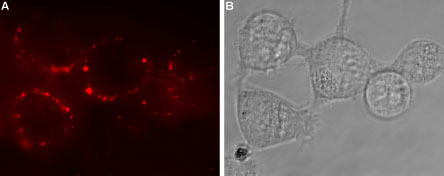Overview
- Peptide CLSSPKQTRIRETR, corresponding to amino acid residues 31-44 of rat GABRR3 (Accession P50573). Extracellular, N-terminus.

 Western blot analysis of rat eye (lanes 1 and 3) and ARPE-19 (lanes 2 and 4):1,2. Anti-GABA(A) ρ3 Receptor (GABRR3) (extracellular) Antibody (#AGA-020), (1:200).
Western blot analysis of rat eye (lanes 1 and 3) and ARPE-19 (lanes 2 and 4):1,2. Anti-GABA(A) ρ3 Receptor (GABRR3) (extracellular) Antibody (#AGA-020), (1:200).
3,4. Anti-GABA(A) ρ3 Receptor (GABRR3) (extracellular) Antibody, preincubated with GABA(A) ρ3 Receptor/GABRR3 (extracellular) Blocking Peptide (#BLP-GA020).
 Expression of GABA(A) ρ3 receptor in human ARPE-19 cellsCell surface detection of GABA(A) ρ3 receptor in intact living human retinal epithelium (ARPE-19) cells. Extracellular staining of cells using Anti-GABA(A) ρ3 Receptor (GABRR3) (extracellular) Antibody (#AGA-020), (1:50) followed by goat anti-rabbit-AlexaFluor-594 secondary antibody. B. Merge of A and live view of the cells.
Expression of GABA(A) ρ3 receptor in human ARPE-19 cellsCell surface detection of GABA(A) ρ3 receptor in intact living human retinal epithelium (ARPE-19) cells. Extracellular staining of cells using Anti-GABA(A) ρ3 Receptor (GABRR3) (extracellular) Antibody (#AGA-020), (1:50) followed by goat anti-rabbit-AlexaFluor-594 secondary antibody. B. Merge of A and live view of the cells.
- Martinez-Delgado, G. et al. (2010) Curr. Neuropharmacol. 8, 422.
- Kumar, R.J. et al. (2008) J. Med. Chem. 51, 3825.
- Bormann, J. (2000) Trends Pharmacol. Sci. 21, 16.
- Tortella, F.C. et al. (1989) Trends Pharmacol. Sci. 10, 501.
- Johnston, G.A. (1996) Trends Pharmacol. Sci. 17, 319.
- Bormann, J. and Feigenspan, A. (1995) Trends Neurosci. 18, 515.
- Cherubini, E. and Strata, F. (1997) News Physiol. Sci. 12, 136.
- Polenzani, L. et al. (1991) Proc. Natl. Acad. Sci. U.S.A. 88, 4318.
γ-Aminobutyric acid (GABA) is the most abundant inhibitory neurotransmitter. It is involved in roughly 40% of inhibitory synapses1,2.
GABA acts through two receptors, GABA(A) and GABA(B). To date, nineteen different GABA(A) subunits have been identified and divided in eight subunits: α (1-6), β (1-3), γ (1-3), δ, ε, ρ (1-3), θ and π. For some of the subunits, alternative splicing further increases the number of existing receptor types. They all have extracellular N- and C-termini and four transmembrane domains1.
Three ρ subunits have been detected: GABA(A) ρ1, GABA(A) ρ2 and GABA(A) ρ3. Like all GABA(A) receptors the ρ subunits also assemble into a pentameric structure forming a Cl- channel. However, in contrast to all other GABA(A) subunits they mostly form homomeric entities. The GABA(A) ρ subunits display different pharmacological characteristics and were therefore once referred to as GABA(C) receptors. GABA(A) and GABA(B) respectively respond to bicuculline and baclofen, whereas ρ subunits are insensitive to either drug3-7. In addition, ρ subunits also display different electrophysiological properties, and are significantly more sensitive to GABA3,5,6,8.
ρ subunits are highly expressed in the retina and it was believed that they are only expressed in that area. They are however, also expressed in central and peripheral nervous systems, as well as in the gastrointestinal and cardiovascular systems1.
Application key:
Species reactivity key:
Alomone Labs is pleased to offer a highly specific antibody directed against an extracellular epitope of rat GABA(A) rho-3 subunit. Anti-GABA(A) ρ3 Receptor (GABRR3) (extracellular) Antibody (#AGA-020) can be used in western blot and live cell imaging applications. It has been designed to recognize GABA(A) ρ3 from human, rat and mouse samples.
